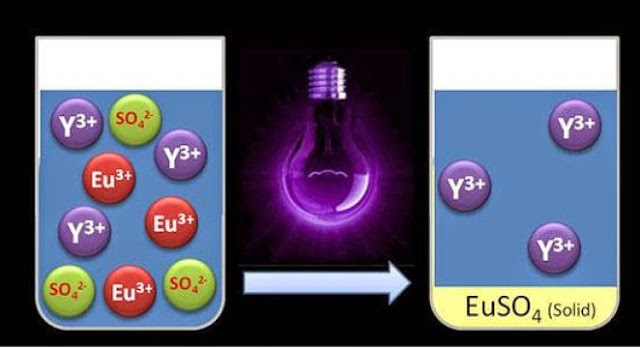
Researchers from the KU Leuven Department of Chemical Engineering have discovered a method to separate two rare earth elements — europium and yttrium — with UV light instead of with traditional solvents. Their findings, which were published in Green Chemistry, offer new opportunities for the recycling of fluorescent lamps and low-energy light bulbs.
Europium and yttrium are two rare earth metals that are commonly used in sustainable technology and high-tech applications. As these rare earth metals are difficult to mine, there is a great interest in recycling them. Europium and yttrium can be recovered from red lamp phosphor, a powder that is used in fluorescent lamps such as neon tubes.
In early 2015, KU Leuven chemists developed ionic liquid technology to recycle europium and yttrium from collected fluorescent lamps and low-energy light bulbs. Their method recycles the red lamp phosphor as a whole to reuse the powder in lamps. For other applications, however, it is necessary to separate europium and yttrium from the rare-earth mixture.
Separating the two rare earth elements is a complicated process. Professor Tom Van Gerven from the Department of Chemical Engineering explains: “The traditional method dissolves europium and yttrium in aqueous acid. An extractant and a solvent are then added to the aqueous liquid, leading to two separate layers known as ‘phases’: an aqueous layer containing the rare earth metals and a solvent layer with the extractant. When the two layers come into contact, one of the two rare earth metals is extracted to the solvent, while the other rare earth metal remains in the aqueous layer.”
But this process leaves much to be desired in terms of efficiency and purity: it needs to be repeated dozens of times to recover a high percentage of a particular rare earth metal, and there will still be traces of yttrium in the europium-containing liquid and vice versa.”
In collaboration with KU Leuven chemists the researchers have now managed to recover europium from the liquid mixture with UV light instead of a solvent. “The UV light influences the electrically charged particles known as ions. Both europium and yttrium have three positive charges per ion. When we shine UV light upon the solution of europium and yttrium, we add energy to the system. As a result, one positive charge per europium ion is neutralized. When we add sulphate, only the europium reacts with it. The result is a precipitate that can easily be filtered, while the yttrium remains in the solution,” says Bart Van den Bogaert, who is preparing a PhD on the subject.
The advantages of UV light are that it does not leave behind any harmful chemicals in the liquid and that the separation efficiency and purity in synthetic mixtures is very high: more than 95% of the europium is recovered from the solution. The precipitate itself is 98,5% pure, so it contains hardly any traces of yttrium. A similar purity was obtained with industrial mixtures, but the efficiency of the separation still needs to be improved. That will be one of the next projects tackled by the KU Leuven researchers.
Reference:
Bart Van den Bogaert, Daphné Havaux, Koen Binnemans, Tom Van Gerven. Photochemical recycling of europium from Eu/Y mixtures in red lamp phosphor waste streams. Green Chem., 2015; 17 (4): 2180 DOI: 10.1039/C4GC02140A
Note: The above story is based on materials provided by KU Leuven.










